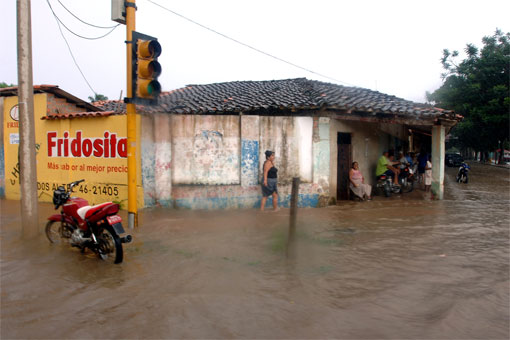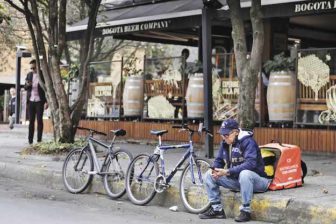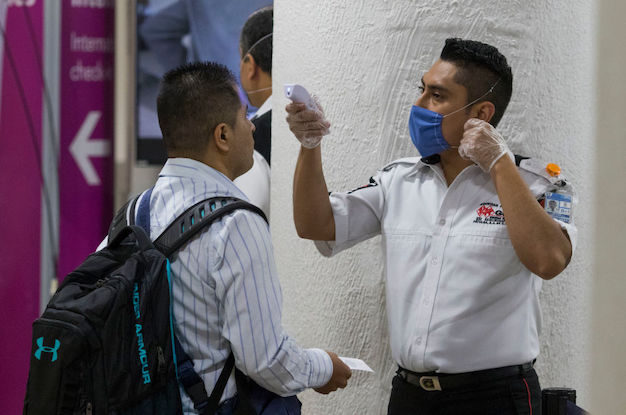When not one, but four, hurricanes pummeled poverty-stricken Haiti between September and November of 2008, relief agencies struggled to deliver emergency aid before the next storm rolled in. Four years earlier, the United States received a costly and deadly reminder that natural disasters wreck havoc on wealthy countries, too. Hurricane Katrina left 80 percent of New Orleans flooded as levees failed to keep out water, emergency response was insufficient, and thousands took refuge in a Superdome that did not meet Red Cross Safety standards.
As cyclone activity increases around the world, The International Federation of the Red Cross and Red Crescent Societies (IFRC) is working to reduce the impact of natural disasters with advanced preparation in response to weather forecasts. The number of hurricanes in the North Atlantic alone was above average for nine of 11 years before 2005, according to the Intergovernmental Panel on Climate change. While the Red Cross/Red Crescent Climate Centre in the Netherlands, founded in 2002, has not found climate change to be directly responsible for any single natural disaster, increasing evidence that rising temperatures lead to storms that are more frequent and more severe makes early preparation all the more important. That is why we are investing more resources into early warning systems that address the risks of extreme weather events in a changing climate.
Be Prepared
The IFRC differentiates between different types of early warnings and corresponding actions by categorizing them into different time and geographic scales. At the shortest timescales, a warning of an impending storm within one to six days allows communities to evacuate. At intermediate timescales, between 10 days and a month, a seasonal forecast can alert us to a particularly severe upcoming storm season or a rainy season that may bring unusual floods. We may also be able to forecast when a continuing drought could result in food scarcity. At even longer timescales, projections of climate change, as well as urbanization and population growth trends can indicate increasing risk.
For seasonal forecasts that are for three-month periods, early action means working locally to assess and address the risks communities may face. While effective international humanitarian preparation and response from headquarters is essential, especially for major disasters, many risk reduction activities need to be implemented at the grassroots level, often by local communities themselves. Awareness of a likely, but still distant, catastrophe offers sufficient time to erect houses with stilts in flood areas, to plant trees that can withstand landslides, to prepare community awareness and prevention programs against the threat of epidemics like dengue fever, or to build water catchment systems in advance of a likely drought. There are literally millions of risk reduction measures that can be taken in response to long-range warnings. The more we act upon such warnings, the better able we will be to identify communities at risk and develop adequate contingency planning, and the more likely will be the savings in lives and livelihoods.
Remarkable advances in science and technology that better predict the location and severity of storms allow for targeted disaster relief preparation. We have known for decades that in most cases, lives are saved and suffering is reduced when relief agencies prepare for natural disasters. It is more effective to evacuate before a flood than to rescue people afterwards, to help farmers weather a severe storm rather than provide emergency food aid once a harvest fails. Early warnings helped the IFRC act early during the 2008 floods in West Africa, and the Climate Centre has partnered with Columbia University’s International Research Institute for Climate and Society (IRI) to implement prevention procedures in Central America and the Caribbean.
Flooding in West Africa in 2007 was the worst in several decades, displacing hundreds of thousands of people in nearly 20 countries and leaving at least 300 dead. The currents literally swept away homes and farmland while roads and bridges collapsed. The dangerously high waters followed a series of heavy flood seasons beginning in 2000. After the disaster, the IFRC West and Central Africa zone office in Dakar, Senegal, took advantage of new partnerships with climate professionals on both sides of the Atlantic, including the African Centre of Meteorological Applications for Development (ACMAD) and the IRI in New York, to regularly monitor seasonal climate forecasts. In late May 2008, two forecasts of heavy rains raised alarm.
The first warning came from the “IFRC Map Room,” a tool created by the IRI at Columbia University. A map generated in May 2008 forecast extreme precipitation for the summer of 2008 in West Africa. The second one was presented at the PRESAO (Prévision Saisonnière en Afrique de l’Ouest), the regional climate outlook forum organized by ACMAD and the Niger Basin Authority, that was attended for the first time by the Red Cross Disaster Management Coordinator in Dakar, Youcef Ait-Chellouche. Climate information helps link disaster response to risk reduction activities and builds a more integrated approach to disaster management, said Ait-Chellouche.
IFRC response to the warnings was swift. The IFRC, which has the capacity to finance early action based on the threat of an imminent disaster, released $558,605 from our Disaster Response Emergency Fund. Given the potential scale of the flooding, the Red Cross/Red Crescent also launched an early appeal for flood preparedness assistance that raised nearly $750,000 from governments and partner agencies to cover the entire at-risk region. The funds enabled the zone office to provide support to Red Cross-Red Crescent branches in individual nations before and during the floods.
The IFRC positioned relief stocks in the regional centers of Dakar, Accra and Yaoundé, so that when the floods occurred, supplies did not have to be flown in from the logistics unit in Dubai—a process that can take two to three weeks. Regional disaster response teams were also trained in flood response. In particular, national Red Cross/Red Crescent disaster managers learned how to interpret six-day rainfall forecasts that could be used to monitor upcoming flood risks. IFRC staff acquired visas and medical insurance in advance, so that international teams could be mobilized within 24 hours of a flood emergency.
In Togo, an especially vulnerable West African country, more people were affected by the 2008 floods in greater numbers of densely populated areas than in 2007. Yet our data show that fewer died in 2008 than in the year before: 16 deaths were recorded rather than 25. This lower death toll may not be entirely attributable to Red Cross action, but the Togo Red Cross staff believes seasonal forecast information relayed early on did enable prompt action. Contingency plans, a larger number of volunteers on call, and a communications system allowed information to pass to and from national headquarters, regional focal points and communities. In pilot communities, where early flood warning systems are being implemented, local volunteers and community leaders continue to monitor river levels and disseminate warnings as appropriate.
Elsewhere in the region, the Red Cross also responded more quickly and more efficiently than it had in 2007. In Ghana, Red Cross volunteers learned that water from the Bagre Dam on the Volta River would be spilled to prevent damage to the dam. They warned fishermen not to go out on the river on the days of excess spillage, thereby avoiding a repeat of the disastrous consequences of a similar discharge in 2007.
At the end of last year’s flood season, in September 2008, the IRI issued its seasonal precipitation forecast for October, November and December, this time predicting above-average rainfall for the dry season. The West and Central Africa Zone Office in Dakar held a community meeting to consider what might be at risk if the dry season was wetter than normal. Farmers quickly raised concerns about nuts and cereals, which are typically dried outdoors in these months. Rain during the dry season could result in crops rotting, putting food security and livelihoods at risk. In partnership with the United Nations World Food Programme and the Food and Agriculture Organization, the zone office identified the precise drying period for certain crops in the region. Staffers then asked national Red Cross offices to travel to farming communities, explaining that rain was possible during the harvest drying time and advising farmers to be prepare to cover or shelter their crops in case of rain.
We hope to replicate our success in Africa in Central America. The Salvadoran Red Cross Society determined that climate change poses new challenges to disaster response and joined our preparedness for Climate Change program in 2007. In the region of Usulután, winds of hurricane strength had been reported for the first time. In the East, there has also been an astonishing decline in rainfall of up to 800 millimeters in the past 70 years. In some regions, Dengue fever appeared earlier in the year. Red Cross youth groups in El Salvador have prepared a ‘nature and youth’ campaign for action, educating people on how to take care of water resources and tree planting initiatives. The IFRC also helped the Salvadoran meteorology department sign on to a regional pilot project for early warning systems.
Action taken in West Africa demonstrated that monitoring seasonal forecasts in a changing climate can save lives, and we hope our efforts in Central America will yield similar results. But climate information on longer timescales is not a trivial undertaking for humanitarian organizations. Like any new scientific or technological tool, seasonal forecasts present challenges as well as solutions. One challenge is uncertainty. While evidence indicates that climate change will lead to more weather extremes, the specific consequences in individual places are often vague and based on probability calculations. In the face of the more pressing day-to-day concerns of farmers and residents, probabilities are easy to ignore.
Communication, something of paramount importance, also presents another challenge. There is a need to transform scientific information, which is often complex and in the form of maps or percentages, into simple and accessible messages that allow people at risk to make sensible decisions on how to respond to impending threats. This requires, first, a continuous dialogue between Red Cross/Red Crescent staff and knowledge centers, including national meteorological services like the The National Oceanic and Atmospheric Administration in the United States or Cathalac in Panama, at national, regional and global levels.
More important, early warnings are irrelevant if they are not received, understood and trusted by those who need to act. Some recent predictions of severe disasters, including Cyclone Nargis, Hurricane Katrina and the food crisis in Niger, went unheeded until it was too late to mitigate the worst damage. As many as 1 million people died after Cyclone Nargis in Myanmar in May of 2008, according to U.S. government estimates. The country had no warning system in place and its military rulers denied international aid workers access to affected areas in the Irrawaddy Delta. Given New Orleans’ flood history, the level of protection offered by the city’s levees had been questioned by engineers long before Katrina battered the Louisiana coastline in August of 2005. Even after observers predicted a food crisis in Niger following a poor harvest in 2004, calls for assistance from the United Nations went unheeded and the country experienced the second worst famine in its history in 2005.
Only by combining scientific advances with the resources and capacities to respond to the warnings—at all time and geographic scales—will we be able to make a difference and counter the rising risks of a changing climate. We have long helped communities prepare for the threats they know. Climate change requires us now to help prepare communities for threats that are unpredictable in both severity and nature. But rather than confusing us by the lack of clarity, these long-term warnings of rising risks and uncertainties should be a strong incentive for increased early action. While a seasonal forecast is less precise than a warning of a storm about to hit a particular city, forecasts give us a valuable heads-up to prepare for higher levels of risk and prepare the ground for action on more specific warnings when they arrive.






